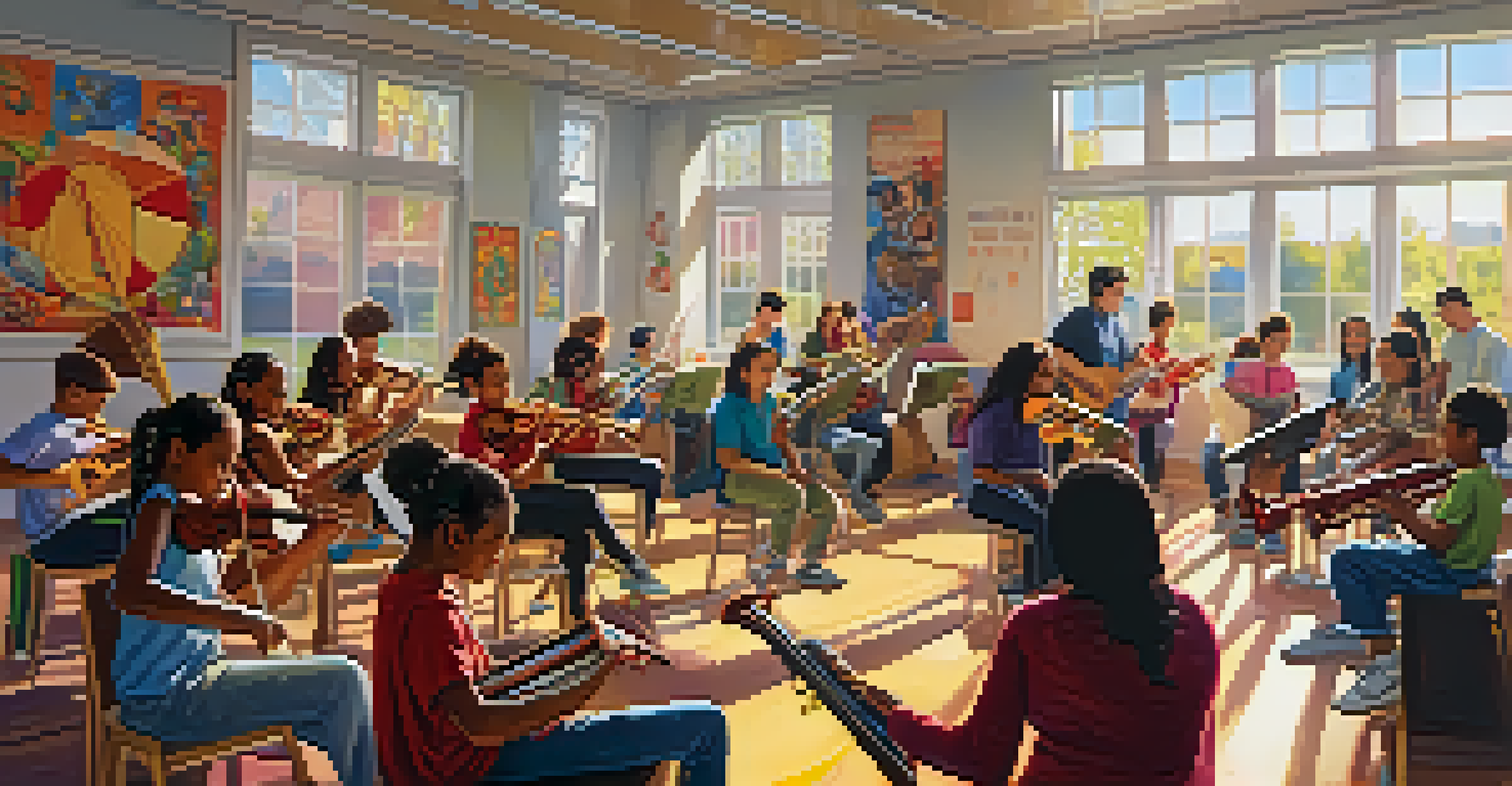Impact of No Child Left Behind on School Music Programs

Understanding No Child Left Behind and Its Goals
No Child Left Behind (NCLB) was enacted in 2001 to improve educational standards across the United States. Its primary goal was to ensure that all students, regardless of background, achieved proficiency in core subjects like math and reading. This legislation aimed to close achievement gaps, increase accountability, and emphasize standardized testing in schools. However, the focus on these core subjects inadvertently led to challenges for arts programs, including music education.
Music education is not just an extra; it is a vital part of a well-rounded education that fosters creativity and critical thinking.
Many schools began to prioritize subjects that were tested, often at the expense of music and other arts programs. As funding and resources were redirected towards math and reading, music programs faced cuts, leading to the reduction of classes, instruments, and even qualified instructors. This shift created a ripple effect, making it increasingly difficult for students to access quality music education.
The emphasis on standardized testing meant that music education was often viewed as a non-essential subject, despite its numerous educational benefits. While NCLB aimed to enhance learning, it raised questions about the value of a well-rounded education that includes the arts, which play a crucial role in fostering creativity and critical thinking.
Effects of NCLB on Music Program Funding
One of the most significant impacts of No Child Left Behind was the reduction in funding for music programs. As schools scrambled to meet federal requirements for core subjects, budgetary constraints forced many to make tough decisions about where to allocate their resources. Unfortunately, music programs were often seen as expendable, leading to a decline in both funding and support.

This decreased funding meant fewer instruments, diminished access to qualified teachers, and limited opportunities for students to engage in music education. Many schools reported having to cut music classes or reduce the number of performance opportunities available to students. This not only impacted the quality of music education but also limited students' exposure to the arts.
NCLB's Impact on Music Funding
No Child Left Behind led to significant funding cuts for music programs as schools prioritized core subjects over the arts.
Ultimately, the financial strain on music programs highlighted a broader issue in education: the need for a balanced approach that values all subjects equally. While NCLB aimed to elevate academic performance in core subjects, it inadvertently marginalized the arts, raising concerns about the long-term effects on students’ overall educational experience.
Impact on Student Participation in Music Programs
As music programs faced cuts, student participation began to decline significantly. Many students who had previously been enthusiastic about joining band, choir, or orchestra found themselves with fewer options and opportunities. This decline in participation can be attributed to both logistical issues, such as lack of funding for instruments, and a cultural shift that downplayed the importance of music education.
The arts are not a luxury; they are a necessity for a complete education and a well-rounded individual.
Fewer classes meant that students who may have been interested in music often had to choose between taking a music class or fulfilling required credits in core subjects. This forced choice often led to students dropping music altogether, resulting in a loss of musical talent and passion within schools. The enthusiasm that once characterized school music programs began to diminish as opportunities dwindled.
Moreover, students who remained in music programs faced larger class sizes and less individual attention from instructors. This shift in dynamics not only affected the quality of education they received but also their overall enjoyment and engagement with music. The once vibrant atmosphere of school music programs began to fade, leaving many students feeling disconnected from their musical pursuits.
The Role of Community Support in Music Education
In response to the challenges posed by NCLB, many communities rallied to support music education in schools. Local organizations, parents, and music enthusiasts began to advocate for the importance of arts education, emphasizing its role in developing well-rounded students. Fundraising events and partnerships with local businesses emerged as critical lifelines for music programs facing budget cuts.
Community support not only helped to maintain existing programs but also sparked new initiatives aimed at enhancing music education. For instance, after-school programs, summer camps, and workshops became popular ways to engage students and provide them with additional musical opportunities. This grassroots movement demonstrated the power of community in preserving the arts, even amidst educational policy challenges.
Decline in Student Participation
As music programs faced budget cuts, student participation in music education declined, limiting opportunities for budding musicians.
Additionally, community support fostered collaboration between schools and local musicians or music educators, enriching students' experiences. Guest artists and mentorship programs introduced students to diverse musical genres and styles, enhancing their learning. Through these efforts, communities showed that music education could thrive despite the constraints imposed by NCLB, highlighting the importance of collective action in preserving the arts.
The Shift in Educational Priorities
The emphasis on standardized testing under NCLB led to a significant shift in educational priorities across the nation. Schools began to focus more narrowly on subjects that would yield higher test scores, often sidelining subjects like music and art. This shift raised concerns about the long-term effects on students' creativity and critical thinking skills, which are often nurtured through exposure to the arts.
As educational priorities changed, so did the perception of music education within schools. Many educators and administrators began to view music as a supplementary subject rather than an essential component of a well-rounded education. This change not only affected the funding and support for music programs but also influenced how students and parents perceived the value of music education.
The shift in priorities also highlighted an important conversation about what constitutes a complete education. Advocates for music education began to push back against the narrowing of curricula, arguing for the inclusion of the arts as vital to student development. This ongoing dialogue continues to remind us that a holistic approach to education benefits students in ways that extend beyond standardized test scores.
Long-term Consequences on Music Education
The long-term consequences of No Child Left Behind on music education are still being felt today. Many schools that experienced cuts to their music programs have struggled to rebuild and restore what was lost. The decline in available resources and support has created a cycle that is difficult to break, leaving many students without access to quality music education.
Moreover, the lack of emphasis on music education has led to a generational gap in musical knowledge and appreciation. Students who missed out on music education during NCLB may find themselves less engaged with the arts in adulthood, impacting cultural participation in their communities. This gap underscores the need for a renewed focus on the arts in education to ensure that future generations have access to the benefits of music.
Community Support for Music Education
Communities rallied to support music education through advocacy and fundraising, demonstrating the importance of arts in schools.
As schools continue to navigate the aftermath of NCLB, advocates are working tirelessly to restore the value of music education. Efforts to reintegrate music into the curriculum are gaining momentum, driven by research that highlights the cognitive and social benefits of music education. The ongoing fight for music programs in schools reminds us that every child deserves the opportunity to explore their musical potential.
The Future of Music Education Post-NCLB
Looking ahead, the future of music education post-NCLB is a subject of much discussion and hope. As awareness grows about the importance of a well-rounded education, more schools are beginning to recognize the value of music programs. Initiatives aimed at restoring funding and resources for arts education are gaining traction, paving the way for a brighter future.
Furthermore, the shift in educational policy towards a more holistic approach, as seen in recent reforms, may provide new opportunities for music education to thrive. Schools are increasingly embracing the idea that arts education is not just an add-on, but a vital component of a comprehensive curriculum that promotes creativity and innovation.

Ultimately, the future of music education will depend on the continued advocacy and support from communities, educators, and policymakers. By recognizing the importance of music in fostering well-rounded individuals, we can ensure that future generations have the opportunity to experience the joy and benefits of music education, creating a richer cultural landscape for all.